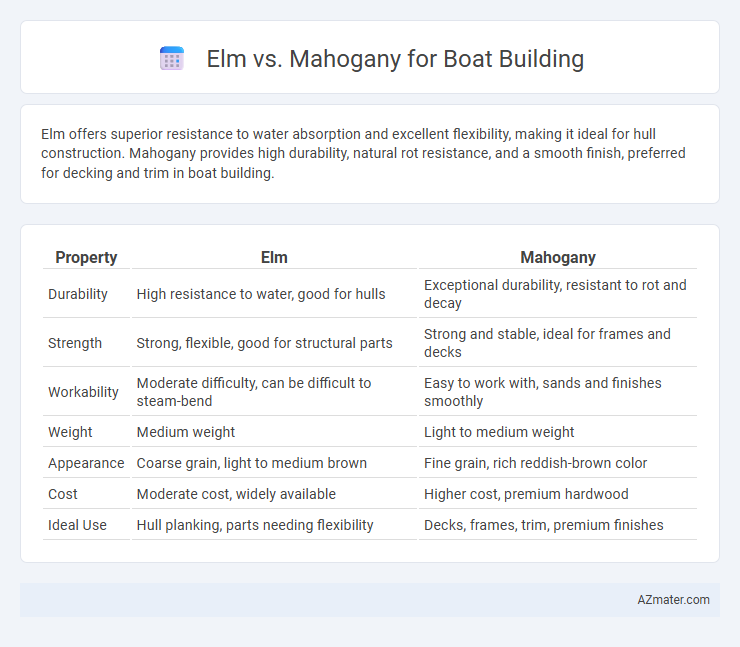Elm offers superior resistance to water absorption and excellent flexibility, making it ideal for hull construction. Mahogany provides high durability, natural rot resistance, and a smooth finish, preferred for decking and trim in boat building.
Table of Comparison
| Property | Elm | Mahogany |
|---|---|---|
| Durability | High resistance to water, good for hulls | Exceptional durability, resistant to rot and decay |
| Strength | Strong, flexible, good for structural parts | Strong and stable, ideal for frames and decks |
| Workability | Moderate difficulty, can be difficult to steam-bend | Easy to work with, sands and finishes smoothly |
| Weight | Medium weight | Light to medium weight |
| Appearance | Coarse grain, light to medium brown | Fine grain, rich reddish-brown color |
| Cost | Moderate cost, widely available | Higher cost, premium hardwood |
| Ideal Use | Hull planking, parts needing flexibility | Decks, frames, trim, premium finishes |
Introduction to Elm and Mahogany in Boat Building
Elm is valued in boat building for its exceptional resistance to water and ability to withstand heavy loads, making it ideal for keels and ribs. Mahogany offers superior durability and a rich, attractive grain, providing both strength and aesthetic appeal in hulls and decking. Both woods have distinct properties that influence their selection based on the boat's design requirements and environmental exposure.
Wood Properties: Strength and Durability
Elm offers excellent resistance to splitting and decay, making it a durable choice for boat building, especially in freshwater environments. Mahogany is prized for its superior strength-to-weight ratio, natural rot resistance, and stability in marine conditions, enhancing boat longevity and performance. Both woods provide robust structural integrity, but mahogany's consistent grain and hydrophobic properties give it an edge in high-moisture, saltwater applications.
Water Resistance and Rot Tolerance
Mahogany is highly valued in boat building for its superior water resistance and natural rot tolerance, making it ideal for prolonged exposure to water. Elm also offers good water resistance due to its interlocking grain, which provides strength and resistance to splitting under wet conditions, but it is generally less rot-resistant than mahogany. Choosing mahogany ensures greater longevity in marine environments, while elm can be suitable for parts less exposed to constant moisture.
Workability and Ease of Shaping
Elm offers exceptional workability and ease of shaping due to its interlocking grain, which resists splitting and makes it ideal for steam bending in boat building. Mahogany, prized for its smooth texture and consistent grain, allows for precise carving and sanding, facilitating detailed craftsmanship. Both woods provide durability, but elm's flexibility makes it especially favored for complex hull curves.
Weight and Buoyancy Considerations
Elm is favored in boat building for its moderate weight and excellent water resistance, contributing to good buoyancy and structural durability. Mahogany, while denser and heavier, offers superior strength and a smooth finish but may reduce overall buoyancy compared to lighter woods. Choosing between elm and mahogany depends on balancing weight sensitivity with the need for robust performance in marine environments.
Cost and Availability in the Market
Elm wood typically offers a more affordable option for boat building due to its abundant availability in North America and Europe, making it easier to source at lower prices compared to mahogany. Mahogany, prized for its durability and aesthetic appeal, commands higher market prices owing to its slower growth rate and limited supply, especially genuine Honduran mahogany which faces strict export regulations. Cost-efficiency in boat construction hinges on choosing elm for budget-conscious projects, whereas mahogany remains a premium choice for high-end vessels requiring superior finish and resilience.
Maintenance and Longevity
Elm offers excellent resistance to water and decay, making it a durable choice for boat building with relatively low maintenance requirements. Mahogany is prized for its natural oils that enhance resistance to rot and marine organisms, resulting in superior longevity and minimal upkeep over time. Both woods require periodic sealing to maintain structural integrity, but mahogany generally provides longer-lasting durability in harsh marine environments.
Environmental Impact and Sustainability
Elm offers moderate sustainability due to its faster growth rates and local availability, reducing the carbon footprint associated with transportation. Mahogany, often sourced from tropical rainforests, poses significant environmental concerns including deforestation and habitat loss, despite its superior durability in marine conditions. Choosing elm for boat building supports eco-friendly practices by emphasizing renewable resources and minimizing ecological damage.
Suitability for Different Boat Types
Elm's natural resistance to water and rot makes it ideal for traditional wooden boats such as rowboats and canoes, where flexibility and shock resistance are crucial. Mahogany offers superior durability and stability, favored for luxury yachts and sailboats requiring a smooth finish and high structural integrity. Each wood's unique properties influence its suitability, with elm excelling in lightweight, flexible vessel construction and mahogany preferred for strength and aesthetic appeal in larger, high-end boats.
Final Verdict: Choosing Between Elm and Mahogany
Mahogany offers superior durability, water resistance, and an attractive grain that makes it a top choice for boat building, particularly for high-end vessels requiring longevity and aesthetic appeal. Elm provides excellent resistance to splitting and warping due to its interlocking grain, making it a cost-effective option for structural components exposed to moisture. The final verdict hinges on budget and performance requirements, with mahogany preferred for premium finishes and elm suited for durable, functional boat parts in more economical builds.

Infographic: Elm vs Mahogany for Boat Building
 azmater.com
azmater.com